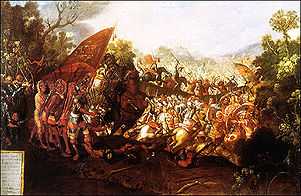Battle of Otumba
| Battle of Otumba | |||||||
|---|---|---|---|---|---|---|---|
| Part of the Spanish conquest of the Aztec Empire | |||||||
 17th century depiction of the battle | |||||||
| |||||||
| Belligerents | |||||||
|
|
| ||||||
| Commanders and leaders | |||||||
| Hernán Cortés | Matlatzincatl †[2] | ||||||
| Strength | |||||||
| Unknown, probably less than 1,000, though significantly inferior in numbers to the Aztecs[1] | ~20,000-40,000 | ||||||
| Casualties and losses | |||||||
| Less than 73 Spanish deaths (only some dozens of spanish warriors were still alive) | unknown but high; ~11,000-13,000 up to over 20,000 | ||||||
The Battle of Otumba was a battle at Otumba de Gómez Farías in 1520.
Background
Around the end of March 1519, Hernán Cortés landed with a Spanish conquistador force at Potonchán on the coast of modern-day Mexico.[3] Cortés had been commissioned by Governor Diego Velázquez de Cuéllar of Spanish-controlled Cuba to lead an expedition in the area,[4] which was dominated by the Aztec Empire.[5] Through a combination of raw force and political maneuvering, Cortés was able to secure the allegiance of the Totonacs and the Tlaxcaltec (subjugated enemies of the Aztec empire) during his advance on the Empire's main settlement, Tenochtitlan.[6] In November, a Spanish force entered the city, and was greeted by its ruler, Moctezuma II.[7] Initially, the conquistadors were treated well by the Aztecs whilst they stayed in the city,[8] but increasing tension by the end of June 1520 led to the forced expulsion of the Spanish and Tlaxcaltec from Tenochtitlan in an event called La Noche Triste (The Sad Night.) [9] Cortés then started a retreat to Tlaxcala, during which his force was harassed by Aztec skirmishers, and the Aztec leadership resolved to eliminate them as they withdrew.[9]
Battle
After being beleaguered on the causeway leading out of the city, the surviving Spanish forces arrived at the plain of Otumba, where they encountered a vast Aztec army. Despite their opponents' exhaustion and hunger, the Aztecs failed to capitalise on their numerical superiority by choosing a vast plain as the battlefield; they were unfamiliar with the use of troops mounted on horses as shock troops, and so were taken aback when mounted Spanish soldiers continually charged at them. For all of their numbers, they were unprepared to endure cavalry charges and were routed by the combined Spanish and Tlaxcalan army after a fierce battle.[10]:303-305
With this hard-fought victory, the Spanish conquistadors were able to regroup and gather their strength for an eventual counter-attack deep into Aztec territory.
See Also
- Spanish conquest of the Aztec Empire
- Cristobal de Olid
- Gonzalo de Sandoval
- Dona Marina
Footnotes
- ↑ 1.0 1.1 Ancient life in Mexico and Central America. Biblo & Tannen Publishers. 1968. p. 312. ISBN 978-0-8196-0205-3.
- ↑ Factional Competition and Political Development in the New World. Cambridge University Press. 1994. p. 109. ISBN 0-521-38400-1.
- ↑ The Spanish Invasion of Mexico 1519–1521. p. 31.
- ↑ The Spanish Invasion of Mexico 1519–1521. p. 12.
- ↑ The Spanish Invasion of Mexico 1519–1521. p. 13.
- ↑ The Spanish Invasion of Mexico 1519–1521. p. 35.
- ↑ The Spanish Invasion of Mexico 1519–1521. p. 44.
- ↑ The Spanish Invasion of Mexico 1519–1521. p. 45.
- ↑ 9.0 9.1 The Spanish Invasion of Mexico 1519–1521. p. 53.
- ↑ Diaz, B., 1963, The Conquest of New Spain, London: Penguin Books, ISBN 0140441239
Sources
- Hewett, Edgar (1968). Ancient life in Mexico and Central America. Biblo & Tannen Publishers. ISBN 978-0-8196-0205-3.
- Robinson III, Charles (2004). The Spanish Invasion of Mexico 1519–1521. Osprey Publishing. ISBN 1-84176-563-5.
- van Zantwijk, Rudolf (1994). Brumfiel, Elizabeth; Fox, John, eds. Factional Competition and Political Development in the New World. Cambridge University Press. ISBN 0-521-38400-1.